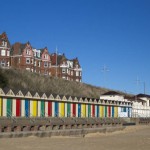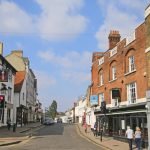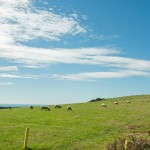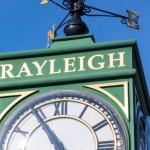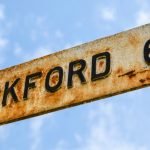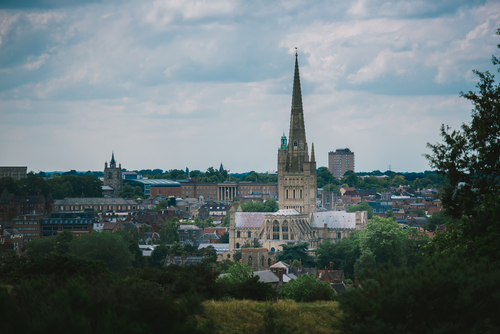
Norwich is a city in Norfolk, East Anglia, England. Situated on the River Wensum, it lies about 100 miles (160 km) northeast of London. The county town of Norfolk, its also recognised by many as being the de-facto capital of East Anglia. Throughout the Middle Ages, up until the dawn of the Industrial Revolution, Norwich was not only one of the most important, but after London, the second-largest city in England. At the 2011 UK Census, Norwich recorded a population of 132,512.
A Fleeting History
During the Roman conquest of Britain, the Celtic Iceni people occupied East Anglia. In 60 AD, one of their leaders, Boudicca, a strong, individualistic woman, led an uprising against Romans’ occupation. While initially successful, the rebellion was ultimately quashed in 61 AD at the Battle of Watling Street, where the rebels faced the full superior might of the invaders’ militia. The Romans then established the regional capital of Venta Icenorum on the River Tas, just south of today’s Norwich.
Soon after the Romans departed Britain at the beginning of the 5th Century, the Anglo-Saxons established the settlement at the confluence of the Rivers Wensum and Yare. The settlement soon became known as Norvic, with ‘Nor’ denoting ‘North’, and ‘vic’ (or ‘wic’) meaning ‘port’ in Old English. Around 575 AD, King Uffa declared Norvic a royal city and the capital of the Kingdom of East Anglia.
In 869 AD, the Danes arrived in East Anglia, killing the incumbent King; Edmund, who turned out to be the last Angle monarch. The Danes settled in the area in large numbers, soon taking up marriage with the local womenfolk. The Viking influence is still very much evident in today’s Norwich, which is borne out by the existence of place names like Pottergate and Finkelgate. Similarly, all across Norfolk, you can find many names of Viking origin.
Following the Norman Conquest of 1066, the new invaders soon cleared the Saxon settlement to build a royal motte and bailey castle. In 1075, the Normans established a new and more permanent marketplace in the Mancroft area, where it has endured in the heart of the city until the present day. Around 1100, the old wooden fort was replaced by a stone structure, which became the residence of the Earl of Norwich. Under the Norman rule, Norwich steadily grew steadily in importance to become a large medieval city.
It was also around 1100, alongside the building of Norwich Castle that the construction of the town’s imposing Cathedral began. In order to bring in the huge amounts of stone required, limestone from Caen in Normandy, a 350-metre canal was built from the River Wensum at Pull’s Ferry to the Bishopsgate site. It took 200 years to complete Norwich’s celebrated cathedral which boasts a 96m high spire and more than 1,000 medieval roof sculptures.
Lets Build A Wall
In 1297, construction of the city’s medieval city walls began. The walls which encompassed the old city were 2.5 miles long, and had a total of 12 gates, which were defended by giant catapults. The ruins of the walls can still be seen at certain locations around the city today. In 1345, the King gifted the castle to the city, with it ultimately being utilised as the county gaol. Hangings outside the castle soon became a regular event. Late Medieval Norwich thrived, becoming the country’s second city, only outdone by London. Buildings such as the Guildhall, Dragon Hall, Strangers’ Hall and St. Andrew’s Hall were all built during the period.
In 1549, Robert Kett led a rebellion by Norfolk farmers against the local landed gentry in a dispute over common land. The government eventually sent troops under the command of the Earl of Warwick, who routed the rebels. Around 300 of the protestors were hanged including Kett, who was ceremonially suspended from the castle walls, as a warning to any would-be dissenters.
During the 16th century, Norwich began to establish links, through trade and cultural exchange, with the Netherlands. The persecution of Protestants in the Spanish Netherlands led to Norwich accepting many of these fleeing European refugees. Many of the migrants, known locally as ‘the strangers’, were weavers. They brought with them valuable new skills, which would greatly help in establishing the city’s textile trade. They also fetched with them some striking little yellow birds in cages. It wasn’t long before Norwich’s townsfolk had taken up the new pastime of rearing canaries.
During the 18th century, a large cattle market developed around the mound of Norwich Castle. The banking and insurance industries also began to emerge, which eventually became synonymous with the city. In 1844, with a fast-growing population, a railway line was constructed between Norwich and Great Yarmouth. The line was soon extended from Norwich to London.
With 36,000 citizens by 1900, Norwich underwent unrelenting population growth during the 19th century. Massive slum clearance was undertaken across the city and the innovative Victorian terraced housing was introduced. It was also during the Victorian period that Norwich’s well-known relationship with the shoe industry was established. In 1925, Colman’s Mustard famously moved from London and established its factory in Norwich, a legacy which is still thriving to this day. In 1899, the town’s ‘ Royal Arcade’, an ornate covered shopping street, designed by George Skipper in an Art Nouveau style, was opened. By this time the city’s population had mushroomed to around 100,000.
Throughout the first half of the 20th century, Norwich continued to develop. From 1900 to 1935 electric trams ran operated in the city, ultimately being replaced by buses. The city’s first cinema opened in 1912, with the Bridewell Museum opening in 1925. Woodrow Pilling Park opened in 1929 and Waterloo Park in 1933. The 1930s also saw the building of the revolutionary Art Deco City Hall overlooking the marketplace. The first council-built houses were built on the outskirts of the city in the 1920s and 1930s. More were built after 1945 since some 3,000 houses were damaged or destroyed by German bombing during WW2.
The Modern Era
In 1963, the University of East Anglia (UEA), with its avant-garde architecture designed by Denys Lasdun, admitted its first students. This was followed in the 1970s by the opening of the Sainsbury Centre for Visual Arts, designed by Norman Foster – his first commercial building, which has since gone on to achieve listed status.
In 1988, the Norfolk Broads, the county’s greatest natural asset was granted national park status, which helped to improve Norwich’s tourist credentials.
Norwich along with Edinburgh are the only places in Britain to have been admitted to the World League of Historical Cities. Set up in Kyoto, Japan in 1987, the WLHC seeks to preserve and regenerate the most iconic towns and cities, around the world. Norwich is in esteemed company, since as well as Kyoto, the likes of Paris, Vienna, Prague, Barcelona, Budapest and Rome are also in the League.
Norwich is twinned with Rouen in France, Koblenz in Germany, Novi Sad in Serbia and El Viejo in Nicaragua.
Getting to Norwich!
By Car
Norwich is 118 miles northeast of London and can be reached via the M11, A14 and A11. It’s about a 3-hour drive in decent driving conditions. To avoid traffic best to leave the capital early morning. From the North, take the A1(M), A17 and A47.
By Bus
Norwich’s Surrey Street bus station provides both local and long-distance services. National Express Coaches run services to Norwich from London and other UK destinations, including London’s main airports. Routes from local villages and towns are operated by First Group.
By Train
Norwich’s Thorpe rail station is ten minutes’ walk from the city centre. The main operators are East Midlands Trains and Abellio Greater Anglia, which provide direct services to London, Ipswich, Colchester, Cambridge and Peterborough. Local services also operate to and from the coastal towns of Great Yarmouth and Lowestoft.
By Air
Norwich International Airport is just over 5 km north of the city centre and operates a regular shuttle bus service into the city. There are all-year-round flights from Amsterdam and Aberdeen, as well as seasonal flights from Jersey, Malta, Spain and Turkey. London Stanstead Airport is just over an hour’s drive away.
Famous People
Some famous people of past and present who have lived or live in Norwich are;
- Edith Cavell (1865–1915) – was born just south of Norwich. A WWI nurse was executed by the Germans for helping Allied prisoners escape. Buried on Life’s Green, Norwich Cathedral
- Robert Kett – famously led a peasant’s revolt in 1549 against the landed gentry. He was hanged for Treason at Norwich Castle on the 7 December 1549
- Bill Bryson, – famed Anglophile, American writer and humorist, lives near Wymondham, near Norwich
- Stephen Fry – comedian, author, actor and filmmaker, studied at Norwich City College
- Sir John Mills – educated at the Norwich High School for Boys. Popular and beloved English actor, his career spanned 7 decades beginning in the 1920s
- Delia Smith – celebrity chef and joint majority owner of Norwich City FC
Some historical facts about Norwich!
- Norwich Cathedral has the second-tallest spire in England, beaten only by Salisbury Cathedral
- During Medieval times Norwich was the second-largest city in England, after London
- During the Middle Ages, there were 58 churches within the city walls
- In 1870, the number of pubs in Norwich peaked at 670
Things to see and do!
Steeped in history, there are loads to see and do in Norwich. Some of the best include:
- Norwich Cathedral – the city’s famed 900-year-old Norman cathedral, has an award-winning restaurant, a rolling programme of exhibitions, an expansive library, a Japanese garden, as well as guided tours.
- Norwich Castle – built as a Norman Royal Palace and once a prison, the Museum and Art Gallery is packed with fine art and archaeology, that includes ancient Egyptian and natural history artefacts.
- The Forum – a contemporary landmark building, housing the municipal library, BBC East, as well as an arts and information centre.
- Sainsbury Centre for the Visual Arts – is a free-entry public arts centre. Opened in 1978, to house the Robert and Lisa Sainsbury Art Collection, it’s a world-class building designed by Norman Foster.
- Norwich Market – trades Monday to Saturday at its original 11th-century location. one of the UK’s biggest and oldest outdoor markets, with 200 stalls of great diversity. Fresh food produce, clothes and handicraft loom large.
- Strangers’ Hall – is a Grade I listed building and a museum recording domestic life in different phases in Norwich’s past.
- Norfolk Broads – on Norwich’s doorstep, a National Park with more than 300 sq. km of lakes and rivers, that’s like nowhere else in the UK.
- Carrow Road – home to Norwich City F.C., who play in the first tier of English football, The Premier League. On average there’s a game every 10 to 11 days from August through to April. Like most EPL games, tickets for matches are scarce and are best booked through the club’s official website.
Where to stay?
There’s accommodation in Norwich to suit most tastes and budgets. A broad indication of prices for commonly available accommodation in the area is:
B & B/Guesthouses/Standard Hotels: £50 – £80
3/4/5 Star Hotels: £80 – £200
Holiday Home/Apartments: £100 – £150 (2 adults sharing)
